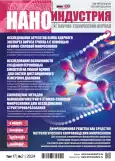Том 17, № 2 (2024)
Нанотехнологии
Наблюдение изменения морфологии пленок высокотемпературных металлов в сканирующем зондовом микроскопе при прогреве в условиях открытого космоса
Аннотация
Наблюдены закономерности изменения морфологии поверхности покрытий из высокотемпературных металлов, которые в качестве защитных покрытий могут наноситься на конструкции космических аппаратов, посылаемых ближе к Солнцу. Показано, что пленки при этом становятся менее рыхлыми, а мелкие зерна этих пленок увеличиваются по размеру, как бы растекаясь по поверхности и перестраиваясь в более крупные образования.
 90-97
90-97


Кварцевая эталонная мера для сканирующей зондовой микроскопии
Аннотация
Повышение точности и достоверности измерений в наномасштабе становится все более актуальной задачей для различных приложений, особенно в таких областях, как полупроводниковая электроника, оптические метаматериалы, сенсоры и биологические измерения. С появлением методов визуализации высокого разрешения закономерно возникла и потребность в метрологической поверке этих приборов. Появилась задача измерить наноразмерную морфологию в конкретном местоположении, что требует точности позиционирования как в вертикальном, так и в латеральном направлении. Стабильность и надежность измерений требуют регулярно отлаживать микроскоп с помощью калибровочных средств. Одним из таких эталонов могут быть кварцевые калибровочные меры.
 98-105
98-105


Исследования возможности создания переменных емкостей на гибкой основе для систем дистанционного измерения давления
Аннотация
Отработана технология напыления кремния, удалось получить прочную поликристаллическую пленку кремния, обладающую хорошей адгезией на подложке ПЭТ толщиной 150…200 нм. С помощью данной технологии был изготовлен опытный образец гибкой переменной емкости. Исследование изменения емкости от изменения воздействующего на него давления имеет линейный вид, что позволяет открывает возможность использования данной технологии для изготовления датчика давления.
 106-112
106-112


Исследование агрегатов белка ядерного экспорта вируса гриппа А с помощью атомно-силовой микроскопии
Аннотация
Белок ядерного экспорта (NEP) играет важную роль во внутриклеточных процессах при инфицировании клеток хозяина. В данной работе впервые с помощью атомно-силовой микроскопии выявлены и охарактеризованы агрегаты различной морфологии и размеров. Полученные результаты могут быть востребованы для разработки новых противовирусных препаратов и создания систем доставки лекарственных средств на основе NEP.
 114-118
114-118


Оборудование для наноиндустрии
Cовмещение методов нанокалориметрии и атомно-силовой микроскопии для исследования структурообразования на наношкале
Аннотация
На данный момент активно развивается широкий спектр аналитических экспресс-методов, предназначенных для физико-химического анализа органических соединений. В данной работе показана возможность исследования микроколичеств полимерных материалов с использованием метода нанокалориметрии на чипе, совмещенного с атомно-силовой микроскопией. В работе создана экспериментальная установка для проведения совмещенных исследований методами сверхбыстрой калориметрии на чипе (нанокалориметрии) и атомно-силовой микроскопии (АСМ), рассмотрены основные технологические аспекты совмещения двух методов, и изучено поведение нанокалориметрического сенсора при взаимодействии с холодным кантилевером АСМ в ходе измерений in situ микроколичеств полимерных материалов при различных температурах.
 120-127
120-127


Дифракционная решетка как средство метрологического сопровождения микроскопии
Аннотация
Визуализация биомедицинских образцов в их естественной среде в микро- и наномасштабе имеет решающее значение для изучения фундаментальных принципов функционирования биосистем со сложным взаимодействием. Для изучения динамических биологических процессов требуется микроскопическая система с множеством измерительных возможностей, высоким пространственным и временным разрешением, универсальными средами визуализации и возможностями локального манипулирования. Перспективными инструментами для этих задач являются сканирующая капиллярная микроскопия и микролинзовая микроскопия, однако корректная работа ни одной из этих методик невозможна без метрологического сопровождения. В данной работе демонстрируется возможность использования для этих целей образца дифракционной решетки.
 128-133
128-133


Экономика
"Индустрия 5.0" – новый вектор промышленного развития
Аннотация
Рассматриваются основные причины перехода к новому этапу развития промышленности и экономики, приведен сравнительный анализ основных концептуальных положений "Индустрии 4.0" и "Индустрии 5.0". Сформулированы основные принципы развития промышленности в условиях перехода к "Индустрии 5.0".
 134-142
134-142


Наноматериалы
Исследование процесса формирования наночастиц оксида меди, стабилизированных глицерил кокоатом
Аннотация
В данной работе образцы наноразмерного оксида меди, стабилизированного глицерил кокоатом, получали методом химического осаждения в водной среде. Исследования микроструктуры методом сканирующей электронной микроскопии показали, что образец оксида меди представлен агломератами неправильной формы размером от 1 до 30 мкм, которые состоят из наночастиц диаметром от 5 до 50 нм. Исследования фазового состава показали, что полученный образец представляет собой оксид меди (II) с кристаллической моноклинной-бета-решеткой, в данном случае пространственная группа соответствует C2/с. В результате компьютерного квантово-химического моделирования взаимодействия глицерил кокоата и оксида меди установили, что представленное соединение является энергетически выгодным (∆E = 1714,492 ккал/моль) и взаимодействие происходит через карбоксилат-анион. Данное соединение обладает значением химической жесткости η ≥ 0,050 эВ, что свидетельствует о его стабильности. Методом ИК-спектроскопии было установлено, что взаимодействие глицерил кокоата и оксида меди происходит через карбоксильную группу. В ходе оптимизации методики синтеза было установлено, что для получения НЧ CuO со средним гидродинамическим радиусом менее 200 нм оптимальными параметрами являются температура от 95 до 100 °С, масса ацетата меди от 3 до 4 г и концентрация стабилизатора ПЭГ-7 от 1–3%.
 144-154
144-154







